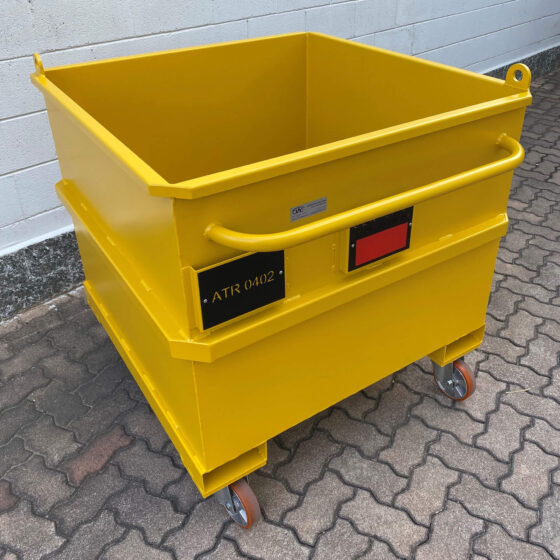Tipping containers

Tipping bins for practical handling of production waste
Metal tipping containers are essential tools for collecting, transporting, and disposing of production waste, such as scraps, chips, and debris. These professional solutions offer convenience and safety in work areas, allowing for easy emptying of their contents through tipping.
Characteristics of tipping industrial bins
Tipping industrial bins are designed to ensure convenience and efficiency in waste collection and disposal processes. These metal tipping containers are equipped with a forkable base that allows lifting with a forklift, greatly simplifying handling operations. . Additionally, various sizes and capacities are available to adapt to the specific needs of each company.
A fundamental feature of tipping industrial bins is the possibility of automatic tipping. Thanks to a controlled tipping mechanism, the operator can empty the container’s contents without having to dismount from the forklift, improving the safety and efficiency of the process.
Advantages of tipping containers
Metal tipping containers offer numerous advantages for material handling.
Ease of use: tipping bins are designed to be easy to use. Thanks to their ergonomic design, they allow for quick and effortless movement and emptying of materials. The tipping mechanism can be operated manually or through a hydraulic system, depending on the chosen model.
Safety: safety is a priority when working with heavy and sharp materials. Tipping containers are equipped with safety systems that prevent accidental tipping during handling operations. For example, some models are equipped with an anti-tipping mechanism that ensures the stability of the container during transport.
Strength and durability: tipping bins are made of sturdy and high-quality materials, such as painted steel or galvanized steel. These materials ensure the strength and durability of the container even under intensive use conditions. Additionally, many models are coated with special materials, such as polyurethane, to protect the container from wear and damage.
Versatility: tipping containers are available in a wide range of sizes and capacities to suit various material handling needs. There are also models of tipping metal containers with wheels, allowing for easy movement of the container from one point to another in the workplace. Some models can be lifted and transported with a forklift, offering additional convenience and flexibility of use.
Types of tipping containers
There are several types of tipping containers, each with its own characteristics and advantages.
Tipping containers with wheels: these are particularly maneuverable and easy to move thanks to bearings-mounted wheels. These models are ideal for material handling on flat surfaces and allow for easy movement of the container from one point to another in the workplace. They are available in various sizes and capacities to adapt to different handling needs.
Forklift tipping containers: these are designed to be lifted and transported with a forklift. These models allow for easy movement of materials from one point to another in the workplace, offering convenience and safety during handling operations. They are available in various sizes and capacities to adapt to different handling needs.
Mesh tipping containers: these are ideal for collecting bulky materials such as cardboard, plastic, wood, and polystyrene. These models feature steel mesh walls and a steel sheet base, which can be used for separating liquids from materials. They are available in various sizes and capacities to adapt to different handling needs.
How to choose the right tipping container
When choosing a tipping bin, it is important to consider various features and factors.
Capacity and size: evaluate the amount of materials that need to be handled and choose a tipping container with the appropriate capacity and size. Ensure that the container can safely and efficiently contain all materials.
Safety features: verify that the tipping container is equipped with adequate safety systems, such as an anti-tipping mechanism or a controlled tipping system. These devices ensure stability and safety during handling operations.
Material and durability: consider the type of material of the tipping bin and ensure that it is sturdy and durable. Painted steel and galvanized steel are common and robust materials used for making tipping containers.
Mobility and convenience: if you need to frequently move the container from one point to another in the workplace, choose a model with wheels or forkable with a forklift. These features offer greater mobility and convenience during handling operations.
Metal tipping containers are practical and safe solutions for material handling. They offer numerous advantages, such as ease of use, safety, strength, and versatility. By choosing the right tipping container, it is possible to optimize material handling operations and ensure an efficient and safe working environment.
Came offers a wide catalog of tipping containers and metal tipping bins.
Visit our product catalog to find the tipping container that best suits your needs. . If you haven’t found the tipping bin for you, contact us for personalized advice and a quote. . In addition to a wide range of standard tipping containers, Came can offer a wide assortment of customizable and tailor-made tipping bins.


